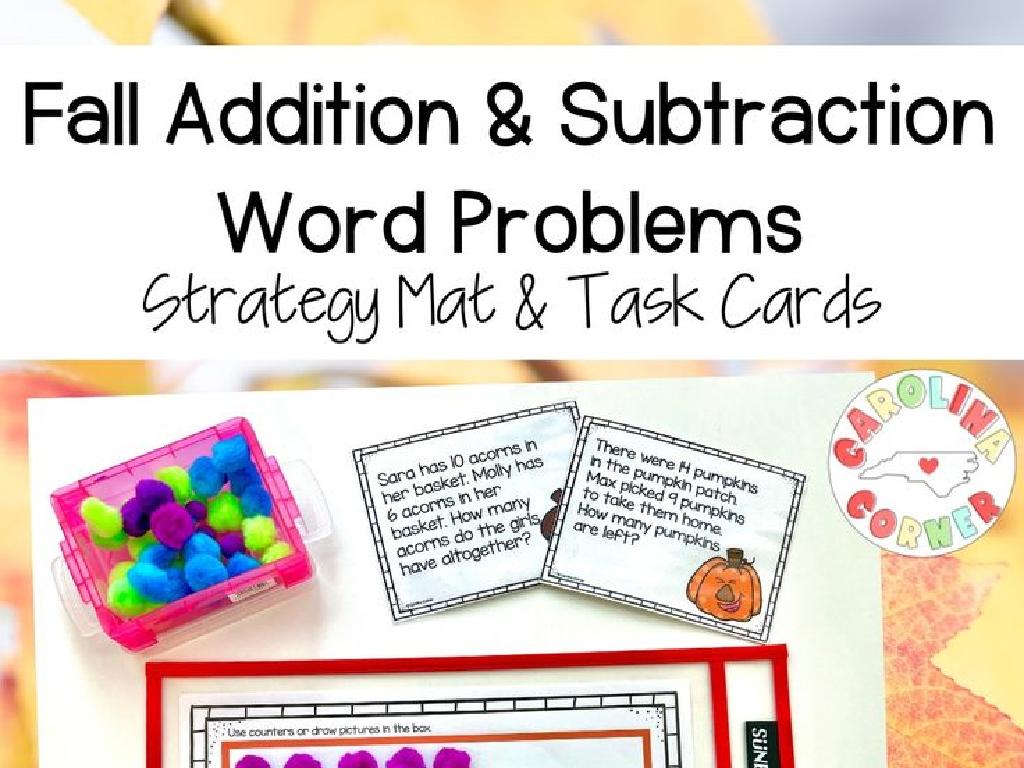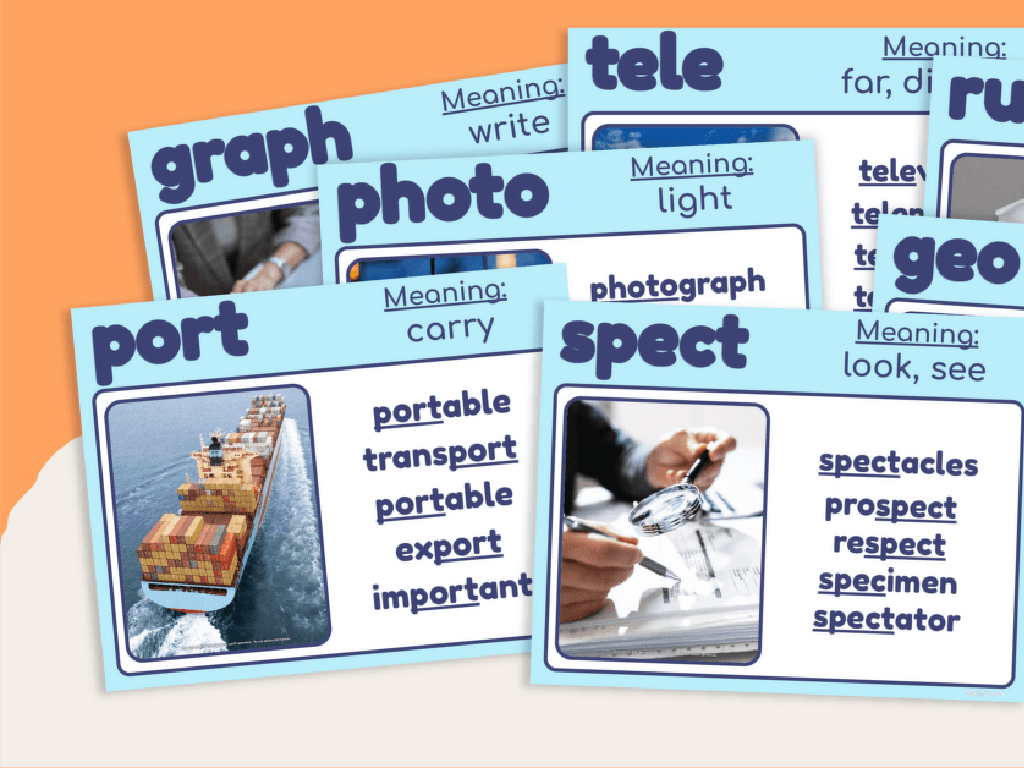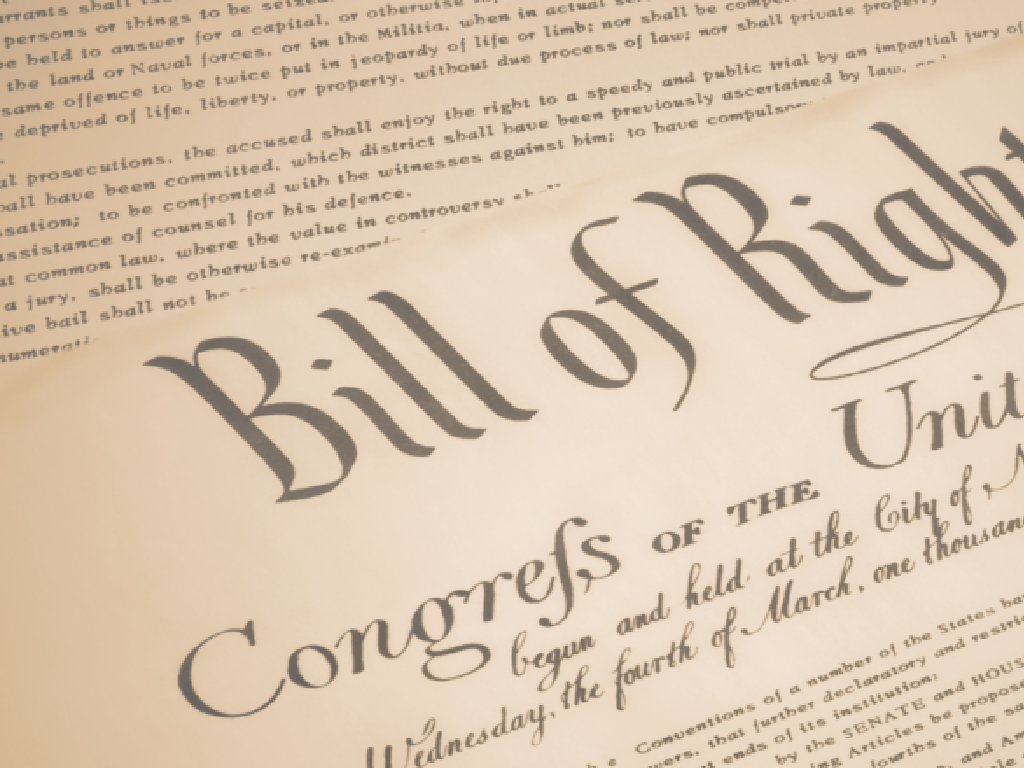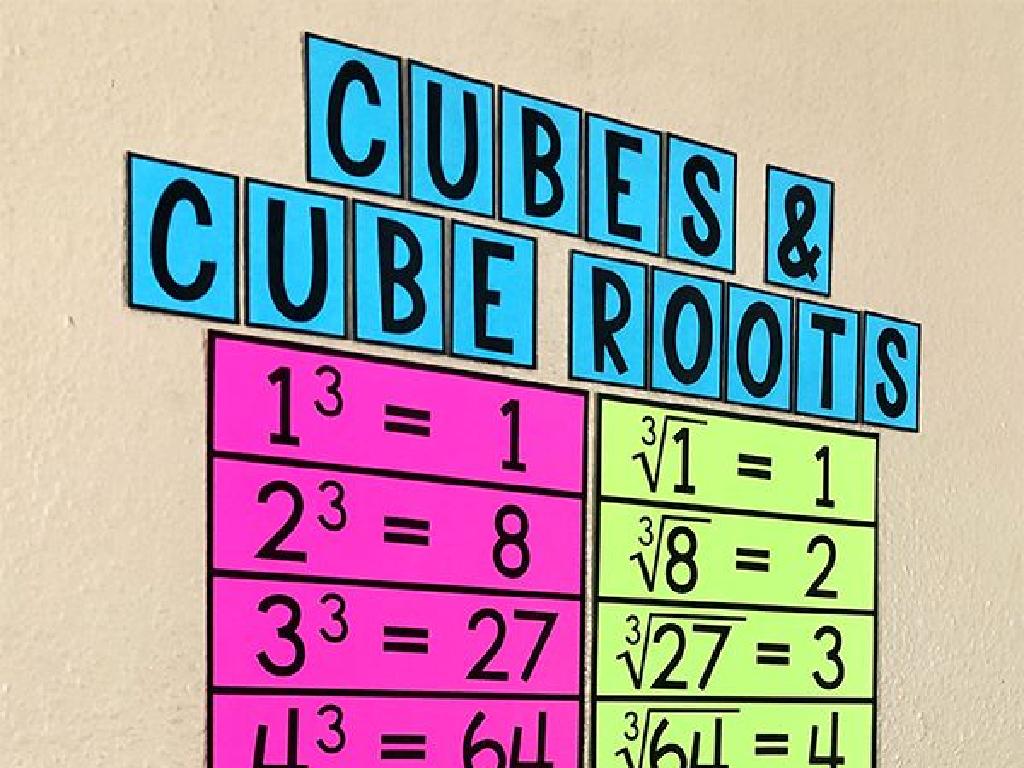Multiply Two Mixed Numbers
Subject: Math
Grade: Fifth grade
Topic: Multiply Mixed Numbers
Please LOG IN to download the presentation. Access is available to registered users only.
View More Content
Multiplying Mixed Numbers
– What are mixed numbers?
– A whole number and a fraction combined, like 2 1/3
– Recap on multiplication
– Multiplication combines groups of equal size
– Today’s goal: multiply mixed numbers
– Steps to multiply mixed numbers
– Convert to improper fractions, multiply, simplify
|
Begin the lesson by explaining what mixed numbers are, ensuring that students understand they consist of a whole number and a fraction. Recap the concept of multiplication as combining equal groups, which they’ve learned in previous grades. Today’s objective is to apply their understanding of multiplication to mixed numbers. Walk through the steps of multiplying mixed numbers: converting mixed numbers to improper fractions, multiplying the fractions, and then simplifying the result. Use visual aids and examples to demonstrate these steps, and prepare to give students practice problems to reinforce the concept.
Understanding Mixed Numbers
– Define a mixed number
– A number made up of a whole number and a fraction, e.g., 2 1/2
– See examples of mixed numbers
– For instance, 3 3/4 (pizza slices), 1 1/2 (hours)
– Identify parts of a mixed number
– Consists of a whole number (e.g., 2) and a fraction (e.g., 1/2)
– Practice with mixed numbers
|
This slide introduces students to the concept of mixed numbers, which are essential for understanding how to multiply two mixed numbers. Begin by defining a mixed number as a combination of a whole number and a fraction. Provide clear examples that students can relate to, such as slices of pizza or durations of time. Explain that a mixed number has two parts: the whole number representing the complete units and the fraction representing the part of a unit. To reinforce the concept, engage students with practice examples where they identify the whole number and fractional parts of mixed numbers.
Multiplication as Repeated Addition
– Review multiplication basics
– Multiplication with fractions
– Multiplication can turn fractions into whole numbers
– Visual example with mixed numbers
– Show adding mixed number to itself
– Practice repeated addition method
– Use visuals to help understand the concept
|
Begin with a quick review of multiplication as repeated addition using whole numbers to refresh the students’ memory. Explain how this concept extends to fractions and mixed numbers. Provide a visual example of adding a mixed number to itself several times to represent multiplication. Encourage students to visualize the process as they work through the steps. This will help solidify their understanding of how to multiply two mixed numbers. Prepare to walk through a few examples as a class, and then let students try some on their own or in small groups.
Converting Mixed Numbers to Improper Fractions
– Why convert to improper fractions?
Improper fractions make multiplying easier.
– Steps for conversion
1. Multiply the whole number by the denominator. 2. Add the numerator. 3. Write the sum over the original denominator.
– Practice with examples
Convert 2 3/4 to an improper fraction. 2*4=8, 8+3=11, so it’s 11/4.
– Apply conversion in multiplication
|
Understanding how to convert mixed numbers to improper fractions is crucial for multiplying them. Start by explaining that improper fractions are often easier to work with in multiplication problems. Demonstrate the conversion steps: multiply the whole number by the denominator, add the numerator, and place the result over the original denominator. Provide several examples for the students to practice and solidify their understanding. Emphasize that this skill is not just for an exercise but a tool they will use in solving more complex multiplication problems involving mixed numbers.
Multiplying Improper Fractions
– Multiply the numerators together
– Multiply the denominators together
– Example: 7/4 x 3/2
– Multiply 7 by 3 and 4 by 2
– Simplify the fraction if possible
– Reduce the fraction to its simplest form
|
When multiplying two improper fractions, students should multiply the numerators (top numbers) together to get the new numerator. Then, multiply the denominators (bottom numbers) together to get the new denominator. For example, to multiply 7/4 by 3/2, multiply 7 by 3 to get 21, and 4 by 2 to get 8, resulting in the fraction 21/8. After multiplying, students should simplify the fraction by finding the greatest common divisor of the numerator and denominator and dividing both by that number if possible. This process helps students understand how to handle fractions larger than one (improper fractions) and prepares them for more complex algebraic operations involving fractions.
Converting Improper Fractions to Mixed Numbers
– Divide numerator by denominator
– Quotient is the whole number
– Remainder is the fraction part
– Example: Convert 7/4 to a mixed number
– 7 ÷ 4 = 1 R3, so it’s 1 3/4
|
After multiplying two mixed numbers, students often get an improper fraction. This slide teaches them how to convert that improper fraction back into a mixed number. Start by dividing the numerator by the denominator to find the whole number part of the mixed number. The quotient from this division is the whole number, and the remainder becomes the new numerator of the fraction part. For example, when converting 7/4, we divide 7 by 4, which equals 1 with a remainder of 3, resulting in the mixed number 1 3/4. Encourage students to practice this method with different improper fractions to become comfortable with the process.
Multiplying Two Mixed Numbers
– Convert mixed numbers to improper fractions
– Example: 2 1/3 becomes 7/3
– Multiply the numerators together
– If 7/3 x 4/5, multiply 7 x 4
– Multiply the denominators together
– For 7/3 x 4/5, multiply 3 x 5
– Simplify the resulting fraction
– 28/15 simplifies to 1 13/15
|
This slide provides a step-by-step guide for students to multiply two mixed numbers. Start by converting mixed numbers into improper fractions, then multiply the numerators and denominators separately. After obtaining the result, simplify the fraction if possible. Use an example like 2 1/3 x 4/5 to illustrate the process. Convert 2 1/3 to 7/3, then multiply by 4/5 to get 28/15, which simplifies to 1 13/15. Encourage students to check their work by asking if the answer is reasonable, considering the size of the original numbers.
Let’s Practice: Multiplying Mixed Numbers
– Practice multiplying mixed numbers
– Work on provided problems
– Solve the problems in your notebook
– Review answers collectively
– We’ll discuss the solutions in class
– Understand the multiplication process
– Grasp the steps involved in multiplying
|
This slide is designed to engage students in active practice of multiplying mixed numbers. Provide a set of problems that students can work on independently, ensuring a range of difficulties to cater to all ability levels. Encourage students to try their best and remind them that making mistakes is a part of learning. After the practice session, review the answers as a class to reinforce the correct methods and address any common errors. This collaborative review will help students understand the multiplication process and learn from each other. Possible activities could include peer review, group problem-solving, or timed challenges to add variety to the practice session.
Class Activity: Mixed Number Multiplication
– Pair up with a classmate
– Solve mixed number problems
– Use multiplication strategies for mixed numbers
– Present your solutions
– Explain your problem-solving process
– Reflect on the activity
– Discuss what you learned and any challenges faced
|
This slide introduces a collaborative class activity focused on multiplying mixed numbers. Students are to work in pairs to encourage teamwork and peer learning. Provide a set of mixed number multiplication problems for each pair to solve. Encourage students to discuss their strategies and problem-solving methods with each other. After solving the problems, each pair will present their solutions to the class, explaining their approach and reasoning. This presentation will help reinforce their understanding and allow for constructive feedback. As a teacher, prepare to guide the students through different methods of solving the problems, such as converting mixed numbers to improper fractions before multiplying, and simplifying their answers. Possible activities could include real-life scenarios where mixed number multiplication is applicable, such as cooking or construction measurements.
Wrapping Up: Multiplying Mixed Numbers
– Review of today’s lesson
– Why learn this skill?
Understanding mixed numbers is vital for advanced math.
– Homework: Practice Worksheet
Complete the worksheet to master multiplying mixed numbers.
– Keep practicing at home!
|
As we conclude today’s lesson on multiplying mixed numbers, it’s important to recap the steps we’ve learned. Emphasize the importance of this skill as it is foundational for understanding more complex mathematical concepts in the future. For homework, students are assigned a practice worksheet that will help reinforce today’s lesson and ensure they are comfortable with the process. Encourage students to attempt the worksheet independently but remind them to reach out if they encounter difficulties. The goal is for students to become confident in multiplying mixed numbers through practice.





